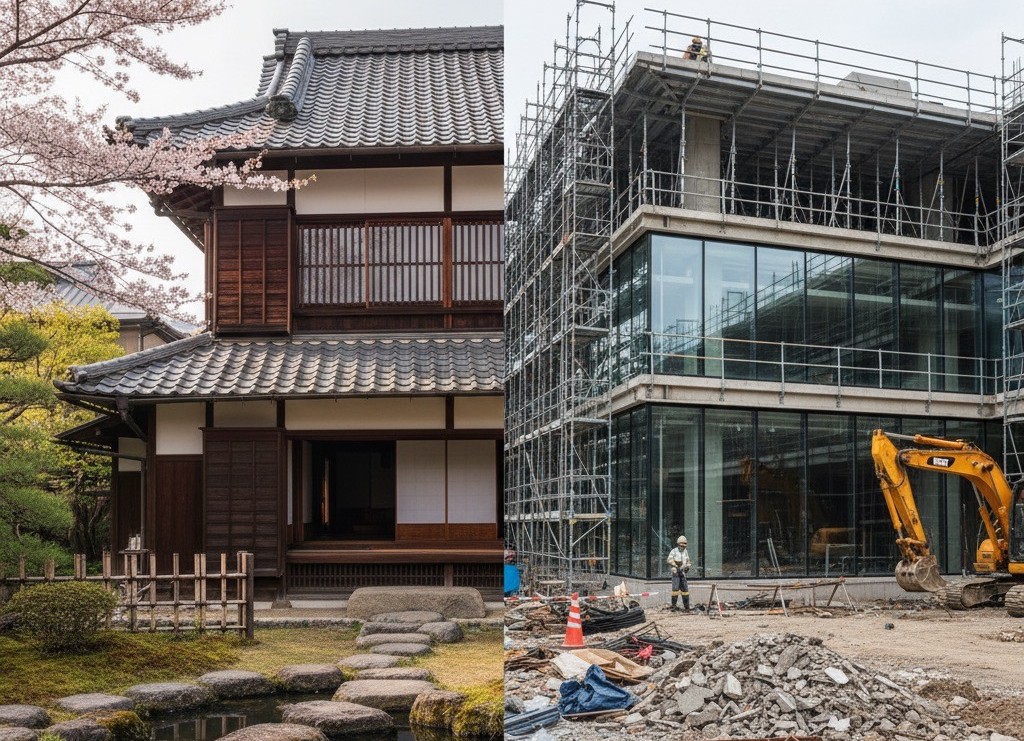Introduction
Historical buildings and cultural heritage around the world face various threats from the forces of modernization, natural disasters, and depopulation. In Japan, in particular, the deepening crisis of “Akiya” (vacant homes) has fueled a major debate: should we “preserve” these old structures, or should we “renovate/demolish” them? This article explores the dilemma of “preservation versus renewal,” using Japan’s “Akiya” issue as a case study to examine the challenges faced by cultural heritage advocates and urban planners, as well as concrete strategies for moving forward.
1. The Importance of Cultural Heritage Protection: Why Preserve?
Historical buildings are not merely “old structures.” They are “living evidence” that narrates the history of the land, the lives of its people, and the societal shifts that have occurred. They hold invaluable worth, including:
- Historical and Educational Value: They serve as vital teaching tools for understanding past technologies and lifestyles, passing them on to future generations.
- Aesthetic and Architectural Value: They possess an artistic dimension, showcasing the unique design elements and craftsmanship of their respective eras.
- Identity and Community: Deeply tied to the local landscape and the memories of residents, they are a source of pride and identity for the local community.
Protecting and utilizing these values are essential for the realization of a sustainable society.
2. The “Preserve or Demolish” Dilemma and Japan’s Akiya Problem
The Peculiarity of Japan’s ‘Akiya’ Issue
In Japan, the discussion surrounding historical buildings is closely intertwined with the “Akiya” problem—structures that have been vacant for long periods. Deterioration, lack of earthquake resistance, and uncontrolled ownership due to inheritance have exacerbated this issue, particularly in rural areas.
- Economic Burden: Maintaining and managing old buildings incurs costs such as property tax and repair expenses. Demolition costs can also be high, placing a significant financial burden on the owners.
- Safety Concerns: Especially in earthquake-prone Japan, old buildings constructed under outdated seismic standards pose a risk of collapse. Demolition is often recommended from a public safety perspective.
- The “New Construction” Culture: Compared to many Western countries, Japan has a strong “new construction” preference, making the culture of renovating and continuing to live in old buildings slow to take root.
The Conflict Between Preservation and Renewal
Faced with old buildings of recognized cultural value, there are difficult choices: should one “fully preserve and restore” (respecting the original integrity), “renovate and adapt” for modern needs (prioritizing usability), or “demolish and repurpose the land?”
3. Approaches to Resolution: Success Stories of Preservation and Adaptation
To protect the value of cultural heritage while ensuring its sustainability in modern society, creative “adaptation” approaches are essential.
Akiya Banks and Promotion of Utilization
In recent years, “Akiya Banks,” where local governments provide information on vacant homes to prospective buyers or those interested in renovation, have gained attention in Japan. Through this mechanism, neglected old folk houses are being reborn as cafés, guesthouses, or community hubs, injecting new vitality into the local economy.
Initiatives in Historic Townscape Conservation Districts
In regions where historical landscapes are highly valued, Japan designates “Important Preservation Districts for Groups of Traditional Buildings” based on the City Planning Act and landscape ordinances. Here, the local government and residents work together on preservation efforts.
- The Case of Sawara (Chiba Prefecture): In this town, which once thrived on water transport and was called “the Venice of the North,” residents’ organizations have worked to preserve the townscape. Maintaining and reusing traditional machiya (townhouses) has successfully attracted tourists and revitalized the local economy.
- Community Building through “Machizukuri”: Efforts go beyond mere building restoration. By having local residents take the lead in planning festivals and events and using historical structures as “living spaces,” these initiatives also contribute to the reconstruction of the community.
Fusion of Earthquake Resistance and Traditional Techniques
To address the challenges in earthquake-prone Japan, efforts are underway to reinforce buildings by respecting traditional architectural techniques while incorporating modern seismic technology (e.g., introduction of seismic isolation or damping devices). This allows for the coexistence of the structural beauty and safety of old wooden buildings.
4. Recommendations for Cultural Heritage Advocates and Urban Planners
Resolving this complex debate requires collaboration among stakeholders and a long-term perspective.
To Cultural Heritage Advocates
- “Visibility” and “Empathy” of Value: Beyond emotional appeals, it is necessary to quantify the historical and economic value of the building and engage in outreach activities that resonate with the general public.
- Proposals for Utilization: Instead of merely insisting on preservation, proposing concrete adaptation plans (cafés, co-working spaces, accommodation facilities, etc.) that can be viable for modern life and business will attract investment and provide the strength to protect the structure.
To Urban Planners and Government Officials
- Flexible Regulations and Incentives: A system that provides economic incentives—such as property tax reductions or subsidies—for the renovation of traditional buildings is crucial to alleviate the financial burden on owners.
- Comprehensive Landscape Planning: Instead of focusing only on individual buildings, it is essential to develop comprehensive “machizukuri” (town development) plans that preserve the historical and cultural landscape of the entire region, balancing regulation with support.
Conclusion
The question of “preserve or demolish” historical buildings is ultimately a question of how we envision the region’s “future.” As Japan’s “Akiya” problem illustrates, complete preservation is not the only answer. The imperative is to respectfully “adapt” these structures, honoring their local history while meeting modern needs, thereby passing them on to the next generation as “living cultural heritage.”
Cultural heritage is a “legacy of the past” that we are borrowing from future generations. It is our mission today to protect this irreplaceable asset with wisdom, technology, and a spirit of collaboration, breathing new value into it.

